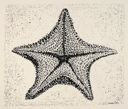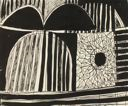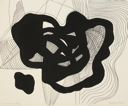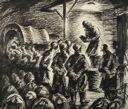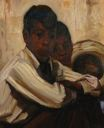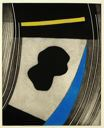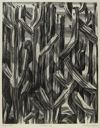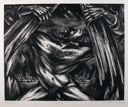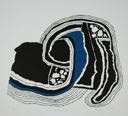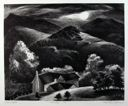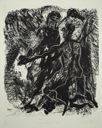Maltby Sykes
American
(Aberdeen, Mississippi, 1911 - 1992, Montgomery, Alabama)
The art of Maltby Sykes reveals an evolution of styles—from Southern Regionalism to Modernist abstraction—over a career that spanned fifty years. From 1941 until he retired in 1977, Sykes was a professor of art at Auburn University in Auburn, Alabama. Sykes, originally from Aberdeen, Mississippi, realized that he wanted to be an artist while he was still in high school in Tuscaloosa, Alabama and he sought instruction at the University of Alabama. Prior to World War II, however, universities had scant resources and facilities for teaching art, and Sykes’s experience was limited to drawing from cadavers at the medical school and taking basic art lessons through the home economics department. (1) He took steps to advance his career by serving apprenticeships in the tradition of the artist-as-craftsman. Lacking access to advanced art schooling in the South, he created his own curriculum of on-the-job training. In 1934 Sykes met the portraitist Wayman Adams in Birmingham. Adams, who had studied with William Merritt Chase and Robert Henri, was based in Elizabethtown, New York, but routinely traveled the country painting portraits on commission. Sykes had begun a fledgling portrait practice of his own under the Works Progress Administration program, and he convinced Adams to allow him to study at his school in Elizabethtown in exchange for secretarial work. While there, Sykes met George C. Miller, a fine-art lithographic printer, and he assisted in Miller’s studio in order to learn the fundamentals of lithographic printing. Miller, a highly skilled lithographic printer, lived in the area and taught Adams’s students the process of lithography. As an assistant to this master printer, Sykes observed techniques and made personal contacts that proved critical to him in later years as he established the printmaking curriculum at Auburn. In the spring of 1935, Maltby Sykes, a twenty-four-year-old artist from Birmingham, Alabama, presented himself at the Mexico City home of Diego Rivera (1886–1957), an internationally renowned painter of murals. Sykes asked Rivera if he might assist in the painting of a mural cycle that was to be executed the following year at the Hotel de Reforma. Rivera examined the young man’s drawings and told him to come back the following December, when preparation was scheduled to begin. Thus began an unforgettable experience, one of several that influenced Sykes’s approach to art for the rest of his life. Sykes’s apprenticeship to Rivera came about through his eagerness to learn more about both mural making and modern art. Rivera had studied in Paris in his youth, and, as Sykes later realized, he himself “had missed something in my art training up to that point. I really didn’t understand what abstraction was about…. So I thought this would be an opportunity to learn something about early twentieth-century art movements.” (2) Working with Rivera on the murals, Sykes learned less about contemporary art than about its potential political impact within the volatile postcolonial Mexican social structure. Rivera’s Marxist philosophy was apparent in his work ethic (he presented himself as a laborer on a par with the others who worked to build the hotel) and in his satirical imagery, which incorporated caricatures of local oligarchs and politicians. Sykes left with a healthy respect for Rivera’s skill as a muralist, as well as an appreciation of his sincere concern for the poor and working classes. (3) The artist later reflected about his many stylistic permutations: “In the course of a lifetime artists do, in fact, develop several visual personalities. They are witnesses of their time and it is inevitable that their work should reflect the succession of ideologies, technologies and social attitudes that occur.” (4)
(1) Laquita Thomson, “Oral History Interview with Maltby Sykes,” 15 January 1987, typescript, artist’s file, Montgomery Museum of Fine Arts Archives, pp. 21–23.
(2) Laquita Thomson, “Oral History Interview with Maltby Sykes,” 15 January 1987, typescript, artist’s file, Montgomery Museum of Fine Arts Archives, p. 46. Sykes later realized that Rivera, as a painter of murals intended to be legible to the masses, had abandoned abstraction as too inaccessible.
(3) Sykes recollected his experience as an assistant to Rivera and his other experiences of Mexico in the article “Diego Rivera and the Hotel Reforma Murals,” Archives of American Art Journal 25, 1–2 (1985). In “Recollections of a Lithographile,” The Tamarind Papers 6 (Summer 1983), he included a reference to the Mexican mural project: “This experience relates to lithography only because, while plastering for Rivera, I was struck by the fact that the surface of lime plaster prepared for fresco painting looks and feels like a lithographic stone” (p. 41).
(4) Maltby Sykes, quoted in "The Spirit of the Modern: Drawings and Graphics by Maltby Sykes" (Athens, GA: Georgia Museum of Art, 2004), p. 14.
American Paintings from the Montgomery Museum of Fine Arts, 2006, cat. nos. 88 and 89, pp. 208-211.
American
(Aberdeen, Mississippi, 1911 - 1992, Montgomery, Alabama)
The art of Maltby Sykes reveals an evolution of styles—from Southern Regionalism to Modernist abstraction—over a career that spanned fifty years. From 1941 until he retired in 1977, Sykes was a professor of art at Auburn University in Auburn, Alabama. Sykes, originally from Aberdeen, Mississippi, realized that he wanted to be an artist while he was still in high school in Tuscaloosa, Alabama and he sought instruction at the University of Alabama. Prior to World War II, however, universities had scant resources and facilities for teaching art, and Sykes’s experience was limited to drawing from cadavers at the medical school and taking basic art lessons through the home economics department. (1) He took steps to advance his career by serving apprenticeships in the tradition of the artist-as-craftsman. Lacking access to advanced art schooling in the South, he created his own curriculum of on-the-job training. In 1934 Sykes met the portraitist Wayman Adams in Birmingham. Adams, who had studied with William Merritt Chase and Robert Henri, was based in Elizabethtown, New York, but routinely traveled the country painting portraits on commission. Sykes had begun a fledgling portrait practice of his own under the Works Progress Administration program, and he convinced Adams to allow him to study at his school in Elizabethtown in exchange for secretarial work. While there, Sykes met George C. Miller, a fine-art lithographic printer, and he assisted in Miller’s studio in order to learn the fundamentals of lithographic printing. Miller, a highly skilled lithographic printer, lived in the area and taught Adams’s students the process of lithography. As an assistant to this master printer, Sykes observed techniques and made personal contacts that proved critical to him in later years as he established the printmaking curriculum at Auburn. In the spring of 1935, Maltby Sykes, a twenty-four-year-old artist from Birmingham, Alabama, presented himself at the Mexico City home of Diego Rivera (1886–1957), an internationally renowned painter of murals. Sykes asked Rivera if he might assist in the painting of a mural cycle that was to be executed the following year at the Hotel de Reforma. Rivera examined the young man’s drawings and told him to come back the following December, when preparation was scheduled to begin. Thus began an unforgettable experience, one of several that influenced Sykes’s approach to art for the rest of his life. Sykes’s apprenticeship to Rivera came about through his eagerness to learn more about both mural making and modern art. Rivera had studied in Paris in his youth, and, as Sykes later realized, he himself “had missed something in my art training up to that point. I really didn’t understand what abstraction was about…. So I thought this would be an opportunity to learn something about early twentieth-century art movements.” (2) Working with Rivera on the murals, Sykes learned less about contemporary art than about its potential political impact within the volatile postcolonial Mexican social structure. Rivera’s Marxist philosophy was apparent in his work ethic (he presented himself as a laborer on a par with the others who worked to build the hotel) and in his satirical imagery, which incorporated caricatures of local oligarchs and politicians. Sykes left with a healthy respect for Rivera’s skill as a muralist, as well as an appreciation of his sincere concern for the poor and working classes. (3) The artist later reflected about his many stylistic permutations: “In the course of a lifetime artists do, in fact, develop several visual personalities. They are witnesses of their time and it is inevitable that their work should reflect the succession of ideologies, technologies and social attitudes that occur.” (4)
(1) Laquita Thomson, “Oral History Interview with Maltby Sykes,” 15 January 1987, typescript, artist’s file, Montgomery Museum of Fine Arts Archives, pp. 21–23.
(2) Laquita Thomson, “Oral History Interview with Maltby Sykes,” 15 January 1987, typescript, artist’s file, Montgomery Museum of Fine Arts Archives, p. 46. Sykes later realized that Rivera, as a painter of murals intended to be legible to the masses, had abandoned abstraction as too inaccessible.
(3) Sykes recollected his experience as an assistant to Rivera and his other experiences of Mexico in the article “Diego Rivera and the Hotel Reforma Murals,” Archives of American Art Journal 25, 1–2 (1985). In “Recollections of a Lithographile,” The Tamarind Papers 6 (Summer 1983), he included a reference to the Mexican mural project: “This experience relates to lithography only because, while plastering for Rivera, I was struck by the fact that the surface of lime plaster prepared for fresco painting looks and feels like a lithographic stone” (p. 41).
(4) Maltby Sykes, quoted in "The Spirit of the Modern: Drawings and Graphics by Maltby Sykes" (Athens, GA: Georgia Museum of Art, 2004), p. 14.
American Paintings from the Montgomery Museum of Fine Arts, 2006, cat. nos. 88 and 89, pp. 208-211.
Artist Objects


















